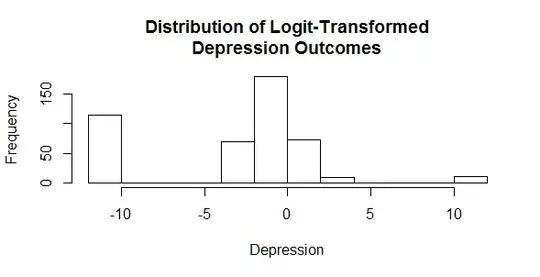A chi-squared test will be simplest and most appropriate. Fisher's exact test tests for differences conditional on fixed margins, which is almost certainly inappropriate here. Logistic regression would be fine, but chi-squared would be simpler; also, LR is really assessing smoking as a function of your groups, which does not quite conceptually match your real question.
d = read.table(text="Groups Yes No All
']10,20]' 35 6 41
']20,30]' 20 13 33
']30,40]' 10 15 25
']40,50]' 15 9 24", header=T)
tab = as.table(as.matrix(d[,-c(1,4)]))
names(dimnames(tab)) = c("Groups", "Smoker")
rownames(tab) = d[,1]
colnames(tab) = names(d)[2:3]
chisq.test(tab)
# Pearson's Chi-squared test
#
# data: tab
# X-squared = 14.697, df = 3, p-value = 0.002095
Let me add a couple additional notes: The chi-squared test only gives you a p-value for the null that the distributions are the same. You may want to characterize how they differ. A couple ways to do this would be to make a table of column-wise proportions, and to make a mosaic plot:
round(prop.table(tab, 2), 3)
# Smoker
# Groups Yes No
# ]10,20] 0.438 0.140
# ]20,30] 0.250 0.302
# ]30,40] 0.125 0.349
# ]40,50] 0.188 0.209
windows()
mosaicplot(t(tab), shade=T)

From these, you can see that there are 'too few' non-smokers in the ]10,20] group, and 'too many' in the ]30,40] group.
If you wanted to use a logistic regression to test these data. It is very simple:
mod = glm(cbind(Yes, No)~Groups, d, family=binomial)
summary(mod)
# Call:
# glm(formula = cbind(Yes, No) ~ Groups, family = binomial, data = d)
#
# Deviance Residuals:
# [1] 0 0 0 0
#
# Coefficients:
# Estimate Std. Error z value Pr(>|z|)
# (Intercept) 1.7636 0.4419 3.991 6.57e-05 ***
# Groups]20,30] -1.3328 0.5676 -2.348 0.018866 *
# Groups]30,40] -2.1691 0.6016 -3.606 0.000311 ***
# Groups]40,50] -1.2528 0.6108 -2.051 0.040249 *
# ---
# Signif. codes: 0 ‘***’ 0.001 ‘**’ 0.01 ‘*’ 0.05 ‘.’ 0.1 ‘ ’ 1
#
# (Dispersion parameter for binomial family taken to be 1)
#
# Null deviance: 1.5415e+01 on 3 degrees of freedom
# Residual deviance: 2.4425e-15 on 0 degrees of freedom
# AIC: 22.657
#
# Number of Fisher Scoring iterations: 3
The test of Groups is not the same as any of the individual tests displayed in the summary output. With only one variable in the model, the test of the variable as a whole is the same as the test of the model as a whole. Unfortunately, R does not give you that by default here as it does for a linear model. You can use the null and residual deviances and degrees of freedom to get a likelihood ratio test, though:
1-pchisq(mod$null.deviance-deviance(mod), df=mod$df.null-mod$df.residual)
# [1] 0.001494036
With only one variable in the model, a convenient way to get the test of the model as a whole is to use anova.glm(). By setting test="LRT", you get the same as the manual method above, and using test="Rao", you get the score test, which is the same as the chi-squared at the top:
anova(mod, test="LRT")
# Analysis of Deviance Table
# Model: binomial, link: logit
# Response: cbind(Yes, No)
# Terms added sequentially (first to last)
#
# Df Deviance Resid. Df Resid. Dev Pr(>Chi)
# NULL 3 15.415
# Groups 3 15.415 0 0.000 0.001494 **
# ---
# Signif. codes: 0 ‘***’ 0.001 ‘**’ 0.01 ‘*’ 0.05 ‘.’ 0.1 ‘ ’ 1
anova(mod, test="Rao")
# Analysis of Deviance Table
# Model: binomial, link: logit
# Response: cbind(Yes, No)
# Terms added sequentially (first to last)
#
# Df Deviance Resid. Df Resid. Dev Rao Pr(>Chi)
# NULL 3 15.415
# Groups 3 15.415 0 0.000 14.697 0.002095 **
# ---
# Signif. codes: 0 ‘***’ 0.001 ‘**’ 0.01 ‘*’ 0.05 ‘.’ 0.1 ‘ ’ 1
Lastly, the naming of your rows (i.e., the Groups) is suspicious. Is this the result of categorizing an originally continuous variable? If so, that is very much not recommended. The categorization can arbitrarily create the appearance of different distributions where they don't actually exist. To get a sense of this, it may help to read this excellent answer (although the context differs): Assessing approximate distribution of data based on a histogram. You would do much better to use the original continuous values and decide a-priori what kind of difference in the distributions you might care to detect (mean shift, difference in spread, skew, heavy-tailedness, other tail behavior, multi-modality, etc.), and test for that explicitly.
